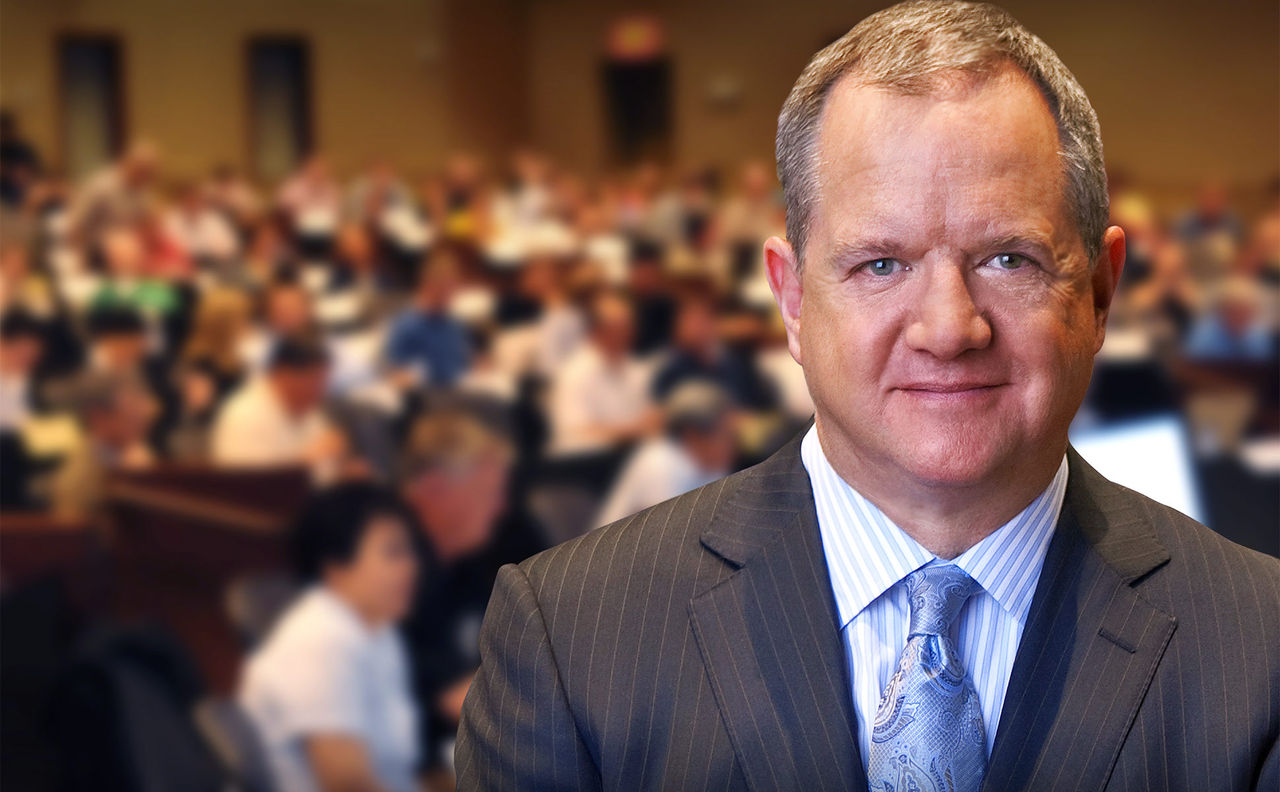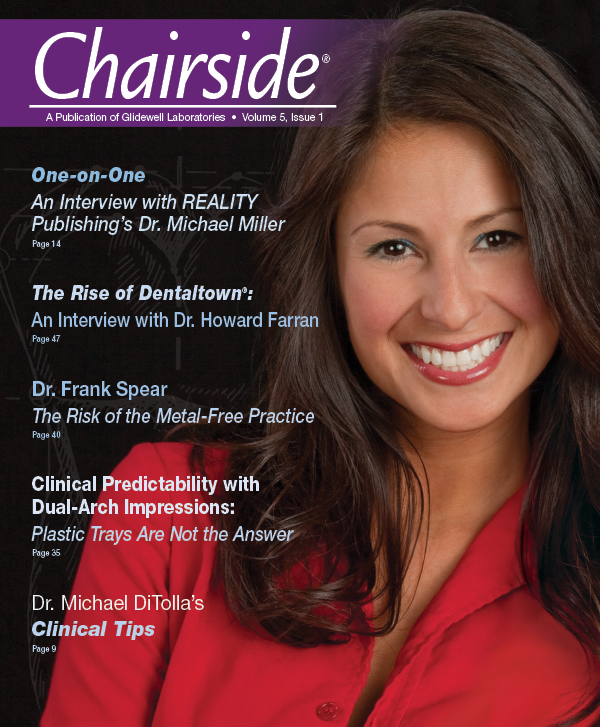The Risk of the Metal-Free Practice

As a practicing prosthodontist for nearly 30 years, the reality of clinical failure is something I know too well. Whether it is a failed endo on a critical tooth in a reconstruction, failed implant, broken solder joint, or the topic of this editorial — the failure of a dental material — all failures evoke multiple challenges for the practitioner. First, there is the patient’s frustration. Regardless of how long the restoration was present, most patients are not pleased when a restoration needs to be redone. Next, there is frustration for the office because failures usually mean that an emergency visit is added to the schedule in order to solve the problem in the short term. And then there is the frustration for the practitioner, not only at having to redo your own work but also of having to deal with what may be an irritated patient. And finally, of course, there is the big question of how to handle the finances.
It is not the purpose of this editorial to focus on how or why you financially manage your failures. However, I believe for many of us it is how long the restoration functioned successfully that determines what we may or may not charge the patient. Generally, if we are talking about less than three years of service, there would be minimal to no charge for the redo — unless you really do not like the patient and want them out of your practice.
What I do think is relevant to this editorial is the cost to the office of redoing restorations that failed early, at no charge. For the sake of simplicity, let us assume that you placed a maxillary first molar crown on a patient and charged them $1,000. Let us also assume that your office has an overhead in the 65% range, as many in the country do. Therefore, your net profit on the crown was $350. Now, 18 months later, the distal marginal ridge of the crown fractures, requiring the restoration to be redone. Assuming you choose to redo the restoration at no charge, as many would do, let us see what it will cost you. If you have a busy practice and full schedule, you will have to take up a productive space where you could have been doing a new crown on someone else to redo the broken one. Assuming you have not raised your fees, you just gave up $1,000 of production to make time to redo the broken crown. But it is actually much worse than that because you also have to pay the office overhead and the laboratory fee to redo the broken crown, which costs you $650. If you add up the $1,000 you did not produce with the $650 you had to pay, the single broken crown redone at no charge could cost you $1,650 in gross revenue. Suffice it to say that redoing failed dental work at no charge is a recipe for financial disaster in the office. So, am I saying that you should charge for all redos? Not at all, as I believe that doing so can be a public relations disaster. Instead, what I am saying is that it is critical to look at methods for minimizing the risk of failure, and for this editorial specifically, the risk of dental materials.
To discuss the risks of different dental materials, it is important to identify which teeth are at the greatest risk of early restorative failure, usually fractures. This is easy, as the research is overwhelming; posterior teeth, particularly the first and second molars, are at the highest risk of failure. This is also simple to understand when we recognize that the average occlusal forces generated on molars are nine times higher than on an incisor. Which brings us to the point of this editorial: why take potential dental material risks if you do not have to?
The answer to that question is not as simple as it may seem. We, as dentists, are an intense and emotional group of people who want to feel we are providing the most current and best care possible for our patients. Often, this focuses on dental materials or new technologies.
In addition, we do not want to feel left behind by our colleagues if they are doing something we perceive as more current than what we are doing. To this end, we sometimes make ill-informed decisions about dental material choices without adequate evidence to support those choices. In addition, as a profession, we have a history of following the speaker at the podium in making our choices. Over the last 10 to 20 years, we have had a greater influx of young speakers than ever before who are starting to speak and are desiring to present a new message different from, perhaps, the status quo, which by itself is not a bad thing; it is only when that message involves suggesting techniques or materials with only a short-term history that the risks to the practitioners in the audience increases.
Let me give you some of my own personal history to illustrate what I mean. In 1986, I listened to legendary dental ceramist Willi Geller lecture in Chicago. To this day, I believe he is truly one of the best, if not the best, technicians dentistry has known. He was presenting on Willi’s Glass, a crown he had developed that used one of the few all-ceramic systems of the day, Dicor, as a coping and overlaid it with Vitadur-N aluminous porcelain. The Dicor gave the fit as it was a cast glass, and the Vitadur-N gave the beauty of layered porcelain. The crowns he presented were easily the most beautiful I had ever seen in dentistry. I came back to Seattle and told my technician that we would now use Willi’s Glass as our standard anterior crown, which we did. The esthetic results were stunning, making all my metal ceramic restorations look like poor substitutes.
But there was a problem: nobody had conducted in vitro or clinical studies on Willi’s Glass. And there was another problem: I had started lecturing nationally in 1983, and by 1987 what do you think I was telling the audience they should use and had no failures and was beautiful? The problems started in about 1989, when the mismatched coefficient of expansion of the Dicor coping and the Vitadur-N started to show up as crowns cracking or experiencing bulk failure. Now remember, by then I had been doing them for three years. In short, by 1991, I had been replacing multiple Willi’s.
Glass crowns monthly for no charge, a huge financial burden on my practice. Was Willi Geller wrong for presenting the material in Chicago? Not at all. He made it clear that it was a new concept without research. The problem was my exuberance at using something I thought was so exciting and esthetic that I jumped in with both feet without considering the consequences.
Examples of other product disasters in our profession abound over the last 25 years. Several of the ceromers (composite) bonded to metal or fiber that were supposed to replace metal ceramics for crowns and bridges at the end of the 1990s come to mind.
Examples of other product disasters in our profession abound over the last 25 years. Several of the ceromers (composite) bonded to metal or fiber that were supposed to replace metal ceramics for crowns and bridges at the end of the 1990s come to mind. In fact, the worst case of material failure I ever heard of was a student in one of my workshops, whose laboratory had convinced her to quit doing metal ceramics and switch exclusively to a ceromer bonded to metal process. Eighteen months after the switch, more than 50% of the restorations failed because of veneering material fractures. All were replaced at no charge. And yet, used as inlays and onlays, without metal or fiber, some of those products have an excellent track record.
Even today, we are practicing in a time when “zirconia” products were going to replace the need for metal in our practices because of the strength of the zirconia framework. In fact, the frameworks have been exceptional, with very little reported framework failures. But I hear countless stories of very high rates of veneering material failures, particularly marginal ridge failures on molars compared with what practitioners have seen with more traditional systems. And, as is often the case, some clinicians and laboratories are having almost no failures. Currently, researchers are looking at framework design, framework adjustment prior to veneering, framework surface treatment prior to veneering, bond strength of the veneering ceramic to the framework, and strength of the veneering ceramic itself as potential causes for these increased rates of failure. This tells me that there are technique and material variables that we do not understand yet that are producing the problem. If we did understand them, we would be able to stop the problem.
Therefore, should you not be using zirconia-based restorations? I believe that that depends upon you and your laboratory’s success rate with them. If you have not had veneering porcelain fractures in the several years that zirconia has been out, the obvious answer is to continue using them. If you have had frequent problems, then stop using them and switch to a different material, or switch to a laboratory that does not have failures with them.
The question you have to ask is whether the success rate on posterior teeth is worth the esthetic gain on molars compared with using products such as gold or metal ceramics that have success rates of 97% to 99% on molars at 10 to 15 years.
This really brings me to the heart of this editorial. What do you gain from the risk you take in choosing among different restorative materials? In choosing an all-ceramic restoration, the gain is always an esthetic one, or in a small group of patients, the lack of having metal in their mouth. Is this risk worth it? In the anterior portion of the mouth, I would definitely say yes. This would include the pre-molars, as well. On the molars, the risk has to be tempered by the facts. I mentioned some not-so-great materials over the last 25 years, but there have been some incredible performers as well, perhaps none better than pressed ceramic. It has enabled large numbers of technicians to produce esthetic restorations at a much higher level than they ever could with metal ceramics. And because it can often be done supragingivally, it has eliminated the challenge of managing and perfecting subgingival margins for the dentist, and benefited the patient as well. Its long-term clinical performance on premolars forward has been exceptional. My friend Dr. Mauro Fradeani, a gifted clinician, published 11-year results of 98.9% success in the anterior. But even in his hands, the success rate on posterior teeth for the same period was 86.6%. The question you have to ask is whether the success rate on posterior teeth is worth the esthetic gain on molars compared with using products such as gold or metal ceramics that have success rates of 97% to 99% on molars at 10 to 15 years. Realize that a success rate of 86.6% means that over 11 years, 13 of every 100 restorations done had to be replaced, as opposed to a gold or metal ceramic replacement rate of one to three per 100 restorations.
If the patient shows little to no evidence of wear on the molars, I will probably use all-ceramic restorations on these teeth as well, if the patient has high esthetic demands. But if the patient shows risk factors such as significant tooth wear, or wants the maximum longevity from the restorations, I will not hesitate to use gold or metal ceramics as my material of choice.
In conclusion, I want to be clear that this is not an editorial about avoiding all-ceramic restorations, nor using only metal ceramic or gold restorations. I believe we have to evaluate each patient, along with their occlusal relationships, occlusal behaviors, esthetic demands and willingness to accept risks of failure in exchange for esthetics, to make an informed decision on which restorative materials we use. For myself, the majority of what I do is all-ceramic from second premolar forward. If the patient shows little to no evidence of wear on the molars, I will probably use all-ceramic restorations on these teeth as well, if the patient has high esthetic demands. But if the patient shows risk factors such as significant tooth wear, or wants the maximum longevity from the restorations, I will not hesitate to use gold or metal ceramics as my material of choice.
Dr. Frank Spear is founder and director of Spear Education. He is also an affiliate professor in the graduate prosthodontics program at the University of Washington and maintains a private practice limited to esthetics and fixed prosthodontics in Seattle. To learn more about Dr. Spear or Spear Education, visit speareducation.com or call 866-781-0072.



